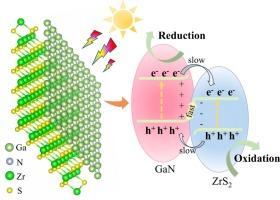High-efficiency photocatalytic water splitting via direct Z-scheme charge transfer in GaN/ZrS2 van der Waals heterojunction
IF 4.7
3区 化学
Q2 CHEMISTRY, PHYSICAL
Journal of Photochemistry and Photobiology A-chemistry
Pub Date : 2025-09-25
DOI:10.1016/j.jphotochem.2025.116801
引用次数: 0
Abstract
Employing density functional theory-based first-principles computations, the optoelectronic properties and photocatalytic water splitting performance of the GaN/ZrS2 van der Waals heterostructure are comprehensively investigated, along with the regulatory effect of biaxial strain. The GaN/ZrS2 heterojunction forms a type-II band alignment with efficient charge separation enabled by van der Waals interactions and Z-scheme charge transfer. The GaN/ZrS2 heterojunction achieves a visible optical absorption rate of up to 13 %, with the absorption spectrum exhibiting a pronounced red shift, significantly superior to single-component materials. Catalytic performance calculations show that the GaN/ZrS2 heterojunction, driven by the synergistic effect of the interfacial built-in electric field and the Z-scheme charge transfer mechanism, enables the hydrogen evolution reaction (HER) and oxygen evolution reaction (OER) to proceed spontaneously, with a solar-to‑hydrogen efficiency () of 28.02 %. Biaxial strain regulation of the GaN/ZrS2 heterojunction reveals that compressive strain (−6 % to 0) decreases the bandgap while inducing a red shift in the absorption edge, whereas tensile strain (0 to 10 %) leads to bandgap widening and a blue shift of the absorption edge, demonstrating the effectiveness of strain engineering in tuning optical absorption. The study demonstrates the broad application prospects of the GaN/ZrS2 heterojunction in photocatalytic water splitting.

GaN/ZrS2 van der Waals异质结中直接Z-scheme电荷转移的高效光催化水裂解
采用基于密度泛函理论的第一性原理计算,全面研究了GaN/ZrS2范德华异质结构的光电性能和光催化水裂解性能,以及双轴应变的调节效应。GaN/ZrS2异质结形成ii型带排列,通过范德华相互作用和Z-scheme电荷转移实现有效的电荷分离。GaN/ZrS2异质结实现了高达13%的可见光吸收率,吸收光谱表现出明显的红移,明显优于单组分材料。催化性能计算表明,在界面内置电场和Z-scheme电荷转移机制的协同作用下,GaN/ZrS2异质结使析氢反应(HER)和析氧反应(OER)自发进行,太阳-氢效率(ηSTH)为28.02%。GaN/ZrS2异质结的双轴应变调节表明,压缩应变(- 6% ~ 0)使带隙减小,吸收边红移,而拉伸应变(0 ~ 10%)使带隙变宽,吸收边蓝移,证明了应变工程在调节光学吸收方面的有效性。研究结果表明,GaN/ZrS2异质结在光催化水裂解中具有广阔的应用前景。
本文章由计算机程序翻译,如有差异,请以英文原文为准。
求助全文
约1分钟内获得全文
求助全文
来源期刊
CiteScore
7.90
自引率
7.00%
发文量
580
审稿时长
48 days
期刊介绍:
JPPA publishes the results of fundamental studies on all aspects of chemical phenomena induced by interactions between light and molecules/matter of all kinds.
All systems capable of being described at the molecular or integrated multimolecular level are appropriate for the journal. This includes all molecular chemical species as well as biomolecular, supramolecular, polymer and other macromolecular systems, as well as solid state photochemistry. In addition, the journal publishes studies of semiconductor and other photoactive organic and inorganic materials, photocatalysis (organic, inorganic, supramolecular and superconductor).
The scope includes condensed and gas phase photochemistry, as well as synchrotron radiation chemistry. A broad range of processes and techniques in photochemistry are covered such as light induced energy, electron and proton transfer; nonlinear photochemical behavior; mechanistic investigation of photochemical reactions and identification of the products of photochemical reactions; quantum yield determinations and measurements of rate constants for primary and secondary photochemical processes; steady-state and time-resolved emission, ultrafast spectroscopic methods, single molecule spectroscopy, time resolved X-ray diffraction, luminescence microscopy, and scattering spectroscopy applied to photochemistry. Papers in emerging and applied areas such as luminescent sensors, electroluminescence, solar energy conversion, atmospheric photochemistry, environmental remediation, and related photocatalytic chemistry are also welcome.

 求助内容:
求助内容: 应助结果提醒方式:
应助结果提醒方式:


